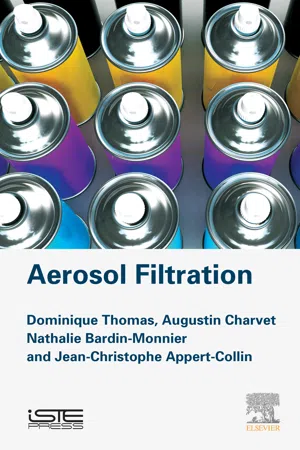
eBook - ePub
Aerosol Filtration
- 226 pages
- English
- ePUB (mobile friendly)
- Available on iOS & Android
eBook - ePub
Aerosol Filtration
About this book
Filtration of aerosols is omnipresent in our daily lives, in areas as diverse as health, the protection of people and the environment, and air treatment inside buildings. However, the collection of particles within a filter media is not, contrary to popular belief, linked to a simple screen effect. The phenomena involved are much more complex and require the consideration of aerosol interactions, filter media and process conditions to select the best fiber filter for a given application. Aerosol Filtration, book for students, hygiene or process engineers, fibrous media manufacturers, designers, and filtration system suppliers or users addresses the filtration of aerosols in six chapters. These chapters cover physics and aerosol characterization, the fibrous media, and efficiency and filter clogging by solid or liquid aerosols, with special attention to the filtration of the nanoparticles.
- Analyses the behavior of fibrous media against solid and liquid aerosols
- Presents models of efficiency and pressure drop
- Introduces computing elements for estimating the lifetime of filters
- Provides guidance for designing filters and predicting their behavior over time
Frequently asked questions
Yes, you can cancel anytime from the Subscription tab in your account settings on the Perlego website. Your subscription will stay active until the end of your current billing period. Learn how to cancel your subscription.
At the moment all of our mobile-responsive ePub books are available to download via the app. Most of our PDFs are also available to download and we're working on making the final remaining ones downloadable now. Learn more here.
Perlego offers two plans: Essential and Complete
- Essential is ideal for learners and professionals who enjoy exploring a wide range of subjects. Access the Essential Library with 800,000+ trusted titles and best-sellers across business, personal growth, and the humanities. Includes unlimited reading time and Standard Read Aloud voice.
- Complete: Perfect for advanced learners and researchers needing full, unrestricted access. Unlock 1.4M+ books across hundreds of subjects, including academic and specialized titles. The Complete Plan also includes advanced features like Premium Read Aloud and Research Assistant.
We are an online textbook subscription service, where you can get access to an entire online library for less than the price of a single book per month. With over 1 million books across 1000+ topics, we’ve got you covered! Learn more here.
Look out for the read-aloud symbol on your next book to see if you can listen to it. The read-aloud tool reads text aloud for you, highlighting the text as it is being read. You can pause it, speed it up and slow it down. Learn more here.
Yes! You can use the Perlego app on both iOS or Android devices to read anytime, anywhere — even offline. Perfect for commutes or when you’re on the go.
Please note we cannot support devices running on iOS 13 and Android 7 or earlier. Learn more about using the app.
Please note we cannot support devices running on iOS 13 and Android 7 or earlier. Learn more about using the app.
Yes, you can access Aerosol Filtration by Dominique Thomas,Augustin Charvet,Nathalie Bardin-Monnier,Jean-Christophe Appert-Collin in PDF and/or ePUB format, as well as other popular books in Physical Sciences & Fluid Mechanics. We have over one million books available in our catalogue for you to explore.
Information
1
An Introduction to Aerosols
Dominique Thomas; Augustin Charvet
Abstract
The term aerosol first appeared around 1920 to designate the suspension, in a gaseous medium, of solid or liquid particles with negligible settling velocity. In air and under normal conditions, these correspond to particles smaller than 100 μm. Gives the dimensions of some of the impurities usually found in air with some comparative elements. An aerosol, by definition, refers to both the particles as well as the gas in which these particles are suspended. However, as a result of constant misuse, the term aerosol is often mistakenly used as a synonym for particles.
Keywords
Diameters; Diffusional parameter; Drag force; Equivalent diameter; Gaseous medium; Knudsen number; Mean free path; Nanostructured particles; Quasi-fractal particles
The term aerosol first appeared around 1920 to designate the suspension, in a gaseous medium, of solid or liquid particles with negligible settling velocity. In air and under normal conditions, these correspond to particles smaller than 100 μm. Figure 1.1 gives the dimensions of some of the impurities usually found in air with some comparative elements. An aerosol, by definition, refers to both the particles as well as the gas in which these particles are suspended. However, as a result of constant misuse, the term aerosol is often mistakenly used as a synonym for particles.

In the field of air-quality surveillance, suspended particles in air are divided into different PMx classes (PM, particulate matter) based on their aerodynamic diameter x (see section 1.4.5):
– PM 10: particles with an aerodynamic diameter smaller than 10 μm;
– PM 2.5: particles with an ...
Table of contents
- Cover image
- Title page
- Table of Contents
- Dedication
- Copyright
- Notation
- Introduction
- 1: An Introduction to Aerosols
- 2: Fibrous Media
- 3: Initial Pressure Drop for Fibrous Media
- 4: Initial Pressure Efficiency of a Fibrous Media
- 5: Filtration of Solid Aerosols
- 6: Filtration of Liquid Aerosols
- Adhesion of Particles
- Index